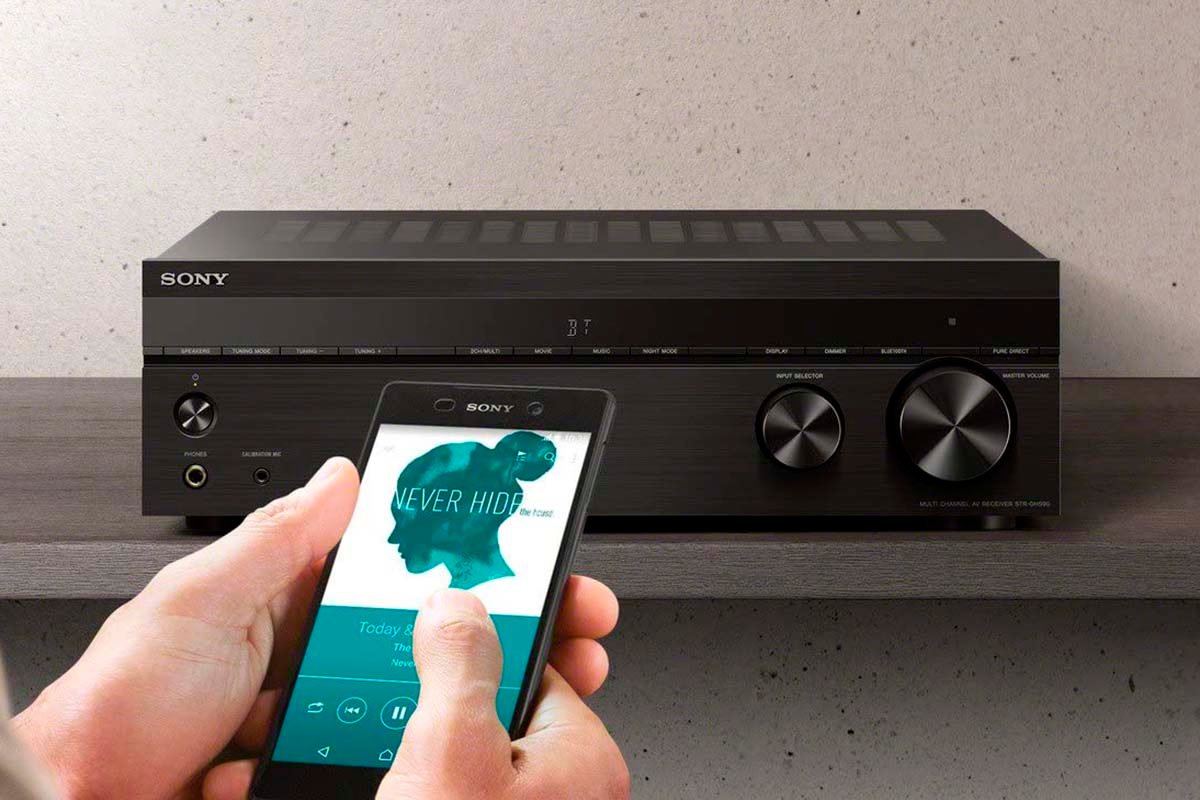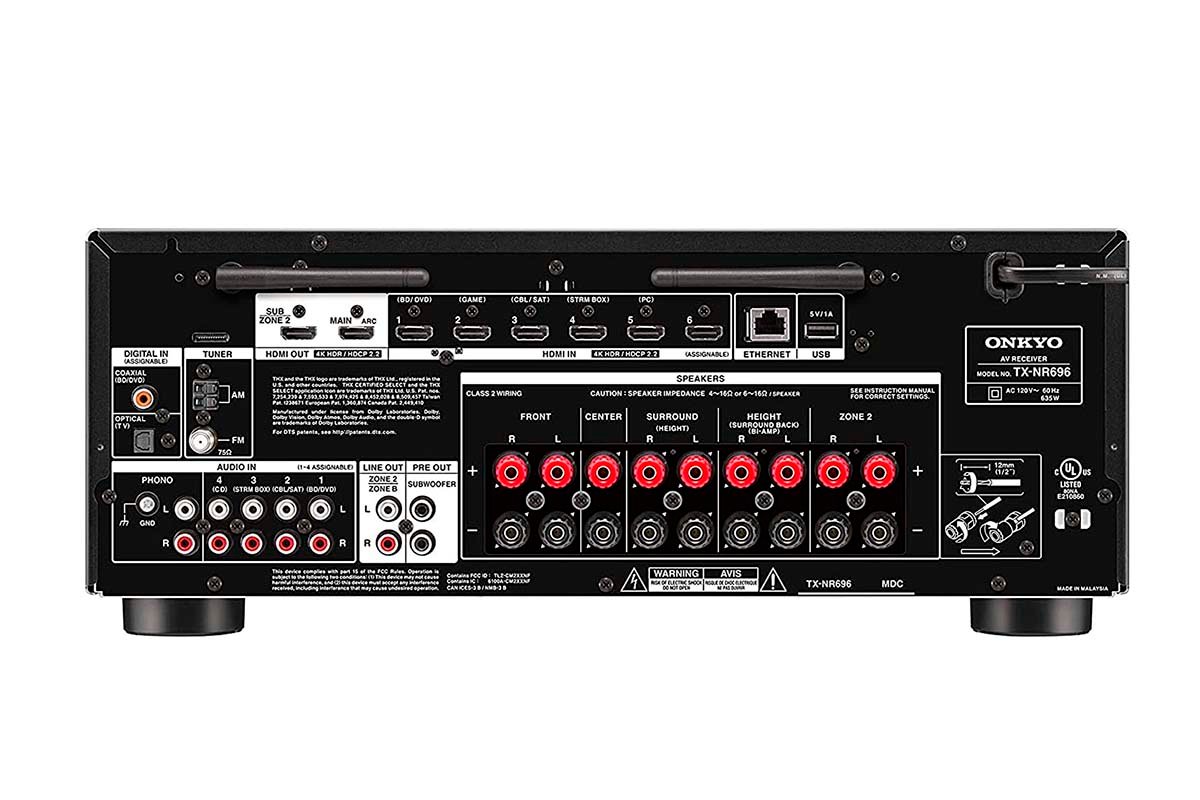Why are receivers so big? Many home theater enthusiasts have posed this question, and there aren’t that many convincing answers for this query.
Generally, home theater receivers are big because they have multiple components to support different audio and video formats. These devices house hardware, including DAC adapters, Bluetooth chipsets, and Wi-Fi adapters. Also, they have big chassis for heat regulation.
The rest of this article will explain the factors that make home theater receivers big. Read on for insights into these and tips on what to look for in an AV receiver.
Reasons Why Home Theater Receivers Are Big

A home theater receiver is a big black box that sits underneath your television or in another convenient location and connects all of your audio and video components.
This device can change channels on your TV, turn off your projector, turn up the volume on your surround sound speakers, switch between copy-protected premium content from different services (like Netflix and Amazon Video), and decode multiple surround formats at once.
To support these functions, these devices are often designed with specific considerations that inevitably affect their size.
Here are the reasons why home theater receivers are big:
To Support Multiple Video Inputs
One of the reasons receivers are massive is because they’re designed to support several video inputs.
These include HDMI (High Definition Multimedia Interface), component video (YUV or YPbPr), VGA (Video Graphics Array), composite video, S-video, and the list goes on.
Video signals require lots of bandwidth because they have high data rates and carry uncompressed digital audio and compressed audio streams like DTS-HD Master Audio and Dolby TrueHD.
Arguably, it’s impossible to support all those formats if receivers lack the necessary hardware and ports for connection.
Because of that, AV receivers are designed with such considerations, making them big.

To Support Multiple Audio Modes
AV receivers are often designed with the flexibility to support different types of audio signals as well.
These include analog-only, digital-only, and other combinations that involve both formats at once.
Because of that, you can expect to find lots of status lights, buttons, and switches inside a typical AV receiver.
The Need for Separate Power Supplies
Home theater receivers are designed with multiple amplifier sections (called “channels”) to drive several pairs of speakers.
To ensure that the receiver’s performance won’t deteriorate if one channel fails, it’s common practice among manufacturers to build them with separate power supplies.
Besides, some AV receiver designs need extra cables for power distribution to eliminate noise and interference generated by AC power lines.
These can affect high-end components like an amp or a DAC (Digital to Analog Converter).
Receivers Are Heavily Cross-Braced for Stability
They’re usually heavily cross-braced within their chassis’ metal framework to ensure stability even if they’re placed in areas with many vibrations from nearby sources.
This measure contributes to the weight of these devices because it increases their overall mass significantly.
There Are Metal Vents for Heat Regulation
Home theater receivers are usually passively cooled, so they don’t feature fans or blowers to regulate their airflow like in a gaming PC’s case.
This is because the amount of heat produced by active cooling mechanisms can affect sound quality and performance, especially from higher-end amps and DACs.
These receivers come in bigger sizes so that manufacturers can add enough metal vents around the chassis to dissipate the generated heat quicker through convection cooling.
This prevents heat build-up inside the device and may cause reliability issues down the road.
Receivers May Have the Power Factor Correction (PFC) Feature
Many home theater receivers are designed with this feature to ensure higher quality and a more stable power supply during operation.
It does affect the overall size of these devices since they need space for PFC circuits and an extra cable junction box to store those components.
There Are Extra Hardware Components
Instead of including all of their technology into one single chip or chipset, some manufacturers prefer building entire boards to accommodate the requirements of each specific function they support.
For example, some home theater receivers come with Bluetooth chipsets onboard. Others have Wi-Fi adapters.
Still, some integrate digital-to-analog converter (DAC) chips into their designs due to the increased demand for digital audio support.
These extra hardware components may seem tiny, but you can expect manufacturers to take advantage of their physical size to add them into the receiver’s chassis.
DACs and AMP Status LEDs
Home theater receivers are designed with separate amplifier sections for each speaker that they support.
This usually means several lights on the front panel, so users will know if any section isn’t working correctly or is on standby mode.
These indicators serve as warning lamps because all amplifiers have to be correctly hooked up to speakers through cables and correctly configured before functioning normally.
If any of these indicators fail, then you might want to troubleshoot the issue by checking if all cables are properly connected or their positions relative to each channel.
Arguably, it would be difficult to enjoy such features if there was no space to accommodate them.
Other Factors To Consider When Buying Home Theater Receivers

Besides their size and weight, there are other factors that you might want to consider when shopping for home theater receivers. These are:
Build Quality and Ease of Use
This is especially true for those who don’t have any knowledge in this area.
Since most receivers come with lots of buttons and switches, some of which are just labeled, you want to make sure that the ones you’re getting are easy to understand and operate without a significant degree of research.
Connectivity Options (HDMI 2.0a/HDCP 2.2 Compliant)
More manufacturers build receivers that support the newest HDMI 2.0a and HDCP 2.2 protocols to ensure compatibility with the latest devices in this market segment, like 4K UHD TVs and external hard drives.
If you’re looking for a home theater receiver that supports both of these standards but has a small form factor, then check out the Onkyo TX-NR696 AV Receiver (available on Amazon.com).
It’s a great option for users who want to save space while benefiting from DTS:X surround sound, HDMI 2.0a and HDCP 2.2 compatibility, and a THX certification.
Dynamic Range Control (DRC)
This allows users to limit the maximum volume output of their home theater receivers by disabling any of the features that may cause the overall volume to increase.
If your home environment is problematic (e.g., if you live in a 2-story house with thinner walls and floors), then it’s going to be very hard to enjoy movies at high volumes without bothering people on other floors, especially if there are no doors or curtains to separate their rooms.
You can solve such situations by setting up a DRC on your receiver, allowing you to limit the volume output of all channels within its range (usually limited to -20 dB to 0 dB).
Audio Processing Capabilities (Dolby Surround, THX Certification)
The best home theater receivers can process audio signals inside their circuitry (instead of just passing them on) to improve output quality for certain types of content.
These processors can support extra features like a built-in concert hall effect or an artificially created surround sound experience.
And the best news is that some of them support both Dolby Surround and DTS:X surround sound formats.
Built-In AM/FM Tuners & USB Ports
I prefer a receiver with a built-in AM/FM tuner because it’s easier to troubleshoot any audio issues I might run into during setup without connecting the unit to my PC.
This is particularly helpful if you use HDMI ARC and your source device suddenly stops sending audio signals through its HDMI output.
You can simply switch to AM/FM to determine if the HDMI has malfunctioned or it’s a different issue.
Physical Connections & Form Factor
It’s important to consider the number of physical connections your home theater receiver should have so you can access many audio devices with it.
For example, if you have an older sound system that uses only analog stereo signals, then it makes no sense for you to buy a unit compatible with HDMI 2.0a and HDCP 2.2 but doesn’t have an analog audio input port, right?
Also, make sure that the unit you’re getting has enough connections for all of your devices.
For example, suppose one of your devices is a new 4K TV with HDMI 2.0a and HDCP 2.2 support.
In that case, you’ll need to make sure that your home theater receiver has an HDMI 2.0a and HDCP 2.2 output as well to authenticate the signal from the source device.
Number of Channels (Power per Channel)
Most manufacturers specify how much power their receivers can deliver per channel. The higher this value is, the better it is for your home theater experience.
But not all channels are equal, so you have to ensure that the one powering your subwoofer is powerful enough to deliver a loud and clear bass response (100W+ is ideal for this).
Bottom Line
When shopping for an AV receiver, you want to keep in mind that most of them are bulky and require a decent amount of space.
When it comes down to the nitty-gritty, they have multiple components inside, which all need to work together seamlessly.
Additionally, some models can get extremely hot because plenty is going on in each component; this is why manufacturers must take heat regulation into account, so everything runs smoothly.
These are some of the reasons these devices come with sizable chassis.

